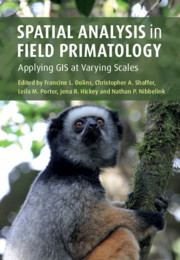Book contents
- Spatial Analysis in Field Primatology
- Spatial Analysis in Field Primatology
- Copyright page
- Dedication
- Contents
- Contributors
- Acknowledgments
- 1 Why Place Matters, and its Use in Primate Behavioral and Ecological Research
- Part I GPS for Primatologists
- Part II GIS Analysis in Fine-Scale Space
- Part III GIS Analysis in Broad-Scale Space
- Introduction
- 15 Modeling Niches and Mapping Distributions
- 16 Does Reduced Habitat Quality or Increased Hunter Access Explain Defaunation of Fragmented Forests?
- 17 Landscape Ecology of Deforestation Processes and Lemur Biogeography in Madagascar
- 18 Quantitative Methods for Primate Biogeography and Macroecology
- 19 GIS and GPS Techniques in an Ethnoprimatological Investigation of St Kitts Green Monkey (Chlorocebus sabaeus) Crop-Foraging Behavior
- 20 Conclusion
- Index
- Plate Section (PDF Only)
- References
17 - Landscape Ecology of Deforestation Processes and Lemur Biogeography in Madagascar
from Part III - GIS Analysis in Broad-Scale Space
Published online by Cambridge University Press: 29 January 2021
- Spatial Analysis in Field Primatology
- Spatial Analysis in Field Primatology
- Copyright page
- Dedication
- Contents
- Contributors
- Acknowledgments
- 1 Why Place Matters, and its Use in Primate Behavioral and Ecological Research
- Part I GPS for Primatologists
- Part II GIS Analysis in Fine-Scale Space
- Part III GIS Analysis in Broad-Scale Space
- Introduction
- 15 Modeling Niches and Mapping Distributions
- 16 Does Reduced Habitat Quality or Increased Hunter Access Explain Defaunation of Fragmented Forests?
- 17 Landscape Ecology of Deforestation Processes and Lemur Biogeography in Madagascar
- 18 Quantitative Methods for Primate Biogeography and Macroecology
- 19 GIS and GPS Techniques in an Ethnoprimatological Investigation of St Kitts Green Monkey (Chlorocebus sabaeus) Crop-Foraging Behavior
- 20 Conclusion
- Index
- Plate Section (PDF Only)
- References
Summary
Although it is now axiomatic that global biodiversity is threatened and that species are going extinct at an accelerating rate (Ceballos et al. 2015), remarkably little is known about the distribution dynamics of many threatened taxa (Brook et al. 2006; Fahrig 2003; Grenouillet & Comte 2014; Guisan et al. 2013). This conservation crisis has spurred the development of new fields of applied research, such as conservation biogeography. Conservation biogeography applies novel conceptual approaches to classic biogeographic models to determine how environmental and anthropogenic changes influence biodiversity (Whittaker et al. 2005). At its core, conservation biogeography focuses on the theory and statistical analyses of spatial dynamics of taxa within a changing environment (Franklin 2010). These dynamic processes include critical questions on how plants and animals respond to changes in habitat availability and use, due to the effects of global warming, forest loss and fragmentation, and anthropogenic pressures (Malcolm et al. 2006; Riitters et al. 2000; Woodroffe & Ginsberg 1998).
- Type
- Chapter
- Information
- Spatial Analysis in Field PrimatologyApplying GIS at Varying Scales, pp. 365 - 382Publisher: Cambridge University PressPrint publication year: 2021



